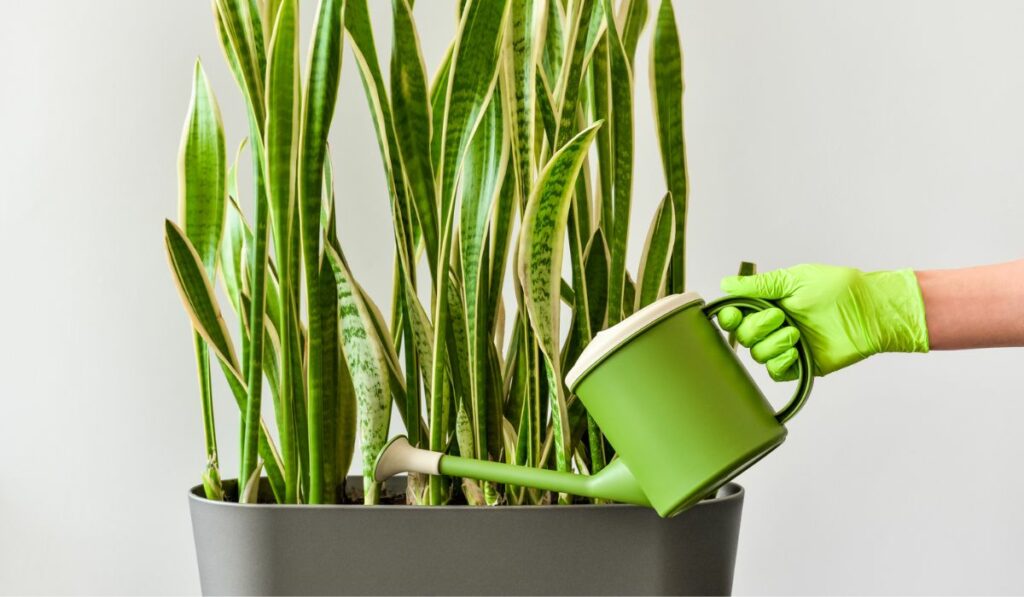Snake plants are virtually indestructible and seem to grow best when they’re ignored. They’re slow growers that prefer bright light, but they’re able to thrive in extremely low light conditions as well. In fact, they’re even capable of surviving under fluorescent lights alone. So, how often should you actually water a snake plant?
You can maintain a thriving snake plant by watering it once a week or when the soil becomes completely dry. Make sure the plant receives at least six hours of indirect sunlight every day. Trim the leaves if they start to fall over and fertilize it with a dose of houseplant food twice every year.
As you can see, with just a minimal amount of effort, you can keep your snake plant happy and healthy. Let’s take a closer look at how often snake plants need to be watered, which environment they grow best in, and how much light they need.
How Often Do Snake Plants Need to Be Watered?

It’s important to note that snake plants are succulents that store water in their roots and leaves. They actually thrive when they’re somewhat neglected, so make sure you only water them when the soil is almost completely dry.
Before you water your plant, it’s best to insert and wiggle your finger a few inches into the soil. If it feels dry, you can still wait one or two days before watering. And if you usually overwater your houseplants, then you should definitely wait a few more days before adding any more water to the soil.
Generally, it’s best to water it once every week. Smaller snake plants can handle up to two weeks without water, while larger ones might need watering every three to four days.
Also, keep in mind that snake plants prefer to completely dry out between waterings. So, if you’ve placed your plant under ample bright indirect sunlight, then you’ll probably only need to water it once every ten days during its growing season.
Similarly, during winters or in low-light conditions, snake plants may only need water as infrequently as once every month. Regardless of the season or placement of your plant, make sure you let the soil dry thoroughly between waterings, or it may lead to root rot and kill your precious plant.
Signs Your Snake Plant Needs More Water
While it’s difficult to do so, under-watering your snake plant is still possible. If your plant is thirsty, the tips of its leaves will turn dry and crispy. Luckily, you can easily fix this problem by pruning its leaves and increasing the watering frequency.
Here are a few other signs that indicate your plant needs more water:
- Brown leaves
- Curling leaves
- The top two to three inches of the soil feel dry
- Brittle and wrinkly leaves
- Slow growth
On the other hand, here are a few signs that you’ve overwatered your snake plant:
- Soft or drooping leaves
- Mushy brown stalks
- Yellow leaves
In Which Environment Do Snake Plants Grow Best?
Snake plants grow best in hot, dry environments, and their roots thrive in loose, well-draining soil with plenty of air pockets. During summer, you can place them outside in bright shade. If your area doesn’t receive any snow or frost, then you can even grow them outdoors as a landscape plant.
Tall, spear-leaved snake plants look amazing in round pots or containers and add a unique, vertical element to any outdoor living space. However, if you live in a rainy region, then it’s better to avoid growing snake plants outside. Since these plants thrive in dry soil, prolonged periods of rain can result in root rot.
On the other hand, if you live in a warmer region, then it’s best to plant tall snake plants as a short hedge along driveways, patios, or walks. However, before you make your plant a permanent part of your landscape, make sure you check with your local nurseries and confirm that the snake plant isn’t invasive in your area.
Repotting Snake Plants
Snake plants grow slowly, so they rarely need to be repotted. In fact, they grow better when they’re pot-bound. If you’ve grown your plant in low light conditions, then you’ll need to repot it every five to ten years.
On the other hand, snake plants that have been grown in brighter light will need to be transplanted every three to six years. There’s no strict schedule you need to follow — you can just wait until your plant grows and breaks its pot before moving it to a larger container.
Remember that a good snake plant container is short and porous. Since these plants spread their roots out as they grow, using too deep a container may result in soil that’s too wet and easy to overwater.
If your snake plant has grown too big for its current container, then opt for a pot that’s one size bigger only if you’re transplanting the entire clump. If you’re planning on dividing the clump, then it’s best to just replant one of the divisions back into the original container.
Make sure you push your snake plant to the exact same depth it was growing in before. Add soil mix around the plant and then tamp it down gently. Add only a few drops of water into the soil to help your plant settle, but wait a few days before giving it a proper soaking.
Trimming Snake Plants
While there’s no real reason to trim snake plants, the leaf tips do sometimes turn brown and crispy, and it’s best to cut those edges off as soon as possible. When you’re making your cut, try to mimic the natural shape of the leaf.
It’s also advisable to prune leaves that fall over. Trim them at the soil level or try to detach them completely from your snake plant if they come loose easily. You can then use those leaves to grow more snake plants.
How Much Light Do Snake Plants Need?

Snake plants are extremely versatile, especially in terms of the amount of light they need. While they thrive in both high and low light conditions, they usually grow more quickly under brighter light. However, it’s important to note that strong direct sunlight will burn their leaves, especially if they’re placed outdoors.
These plants grow best when they receive at least six hours of indirect sunlight every day. To ensure your snake plant gets optimal light, here are some tips on how to position them:
- South-facing windows receive the brightest and most intense sunlight, so it’s better to place your snake plant at least eight to ten feet away from them.
- If you want your plant to get medium sunlight from the morning sun, place it close to an east-facing window.
- If you want your plant to get medium sunlight from the evening sun, place it close to a west-facing window.
Remember that the less sunlight your plant receives, the slower it’ll grow. Make sure you also pay close attention to your pot tag when purchasing a snake plant, as some varieties need a specific light level to achieve the brightest leaf color.
What Fertilizer Is Best For Snake Plants?
When potting a snake plant, it’s best to add commercial potting soil (on Amazon) that has been specifically formulated for indoor plants. You can even add some fir bark, pumice, perlite, or clay pebbles into the soil.
However, since these plants are slow-growers, you’ll rarely need to add fertilizer. In fact, you’ll only need to give them a small dose of houseplant food (on Amazon) twice every year (once in summer and once in spring).
Alternatively, you can just fertilize your snake plants by adding a thin layer of worm compost on top of the soil once every year.








